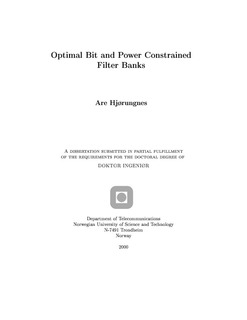| dc.description.abstract | In this dissertation, two filter banks optimization problems are studied. The first problem is the optimization of filter banks used in a subband coder under a bit constraint. In the second problem, a multiple input multiple output communication system is optimized under a power constraint. Three different cases on the filter lengths are considered: unconstrained length filter banks, transforms, and finite impulse response filter banks with arbitrary given filter lengths.
In source coding and multiple input multiple output communication systems, transforms and filter banks are used to decompose the source in order to generate samples that are partly decorrelated. Then, they are more suitable for source coding or transmission over a channel than the original source samples. Most transformers and filter banks that are studies in the literature have the perfect reconstruction property. In this dissertation, the perfect reconstruction condition is relaxed, so that the transforms and filter banks are allowed to belong to larger sets, which contain perfect reconstruction transforms and filter banks as subsets.
Jointly optimal analysis and synthesis filter banks and transforms are proposed under the bit and power constraints for all the three filter length cases. For a given number of bits used in the quantizers or for a given channel with a maximum allowable input power, the analysis and synthesis transforms and filter banks are jointly optimized such that the mean square error between the original and decoded signal is minimized. Analytical expressions are obtained for unconstrained length filter banks and transforms, and an iterative numerical algorithm is proposed in the finite impulse response filter bank case.
The channel in the communication problem is modelled as a known multiple input multiple output transfer matrix with signal independent additive vector noise having known second order statistics. A pre- and postprocessor containing modulation is introduced in the unconstrained length filter bank system with a power constraint. It is shown that the performance of this system is the same as the performance of the power constrained transform coder system when the dimensions of the latter system approach infinity.
In the source coding problem, the results are obtained with different quantization models. In the simplest model, the subband quantizers are modelled as additive white signal independent noise sources. The proposed unconstrained length filter banks, and it is shown that the proposed transform has better performance than the Karhunen-Loève transform. Also, the proposed transform coder has the same performance as a transform coder using a reduced rank Karhunen- Loève analysis transform with jointy optimal bit allocation and Wiener synthesis transform. The proposed finite impulse response filter banks have at least as good theoretical rate distortion performance as the perfect reconstruction filter banks and the finite impulse response Wiener filter banks used in the comparison.
A practical coding system is introduced where the coding of the subband signals is performed by uniform threshold quantizers using the centroids as representation levels. It is shown that there is a mismatch between the theoretical and practical results. Three methods for removing this mismatch are introduced. In the two first methods, the filter banks them selves are unchanged, but the coding method of the subband signals is changed. In the first of these two methods, quantizers are derived such that the additive coding noise and subband signals are uncorrelated. Subtractive dithering is the second method used for coding of the subband signals. In the third method, a signal dependent colored noise model is introduced, and this model is used to redesign the filter banks. In all three methods, good correspondence is achieved between the theoretical and practical results, and comparable or better practical rate distortion performance is achieved by the proposed methods compared to systems using perfect reconstruction filter banks and finite impulse response Wiener synthesis filter banks.
Finally, conditions for when finite impulse response filter banks are optimal are derived. | nb_NO |
